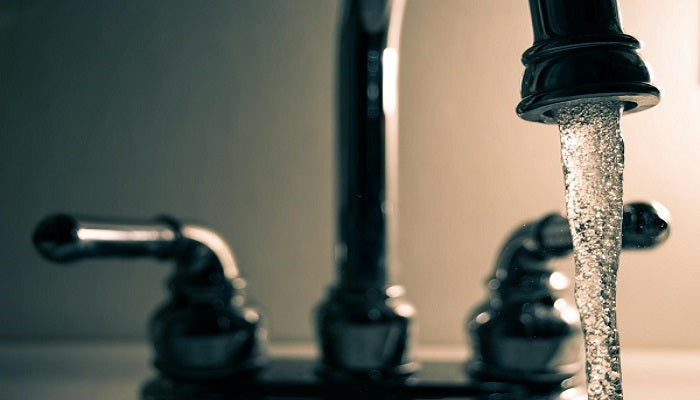What is a Flow Restrictor?
A flow restrictor (also called a water saver disk) is a small device installed inside a showerhead or faucet. Its purpose is to control water flow, conserve water, and maintain stable water pressure. Typically made of plastic or silicone, the device is compact but plays a crucial role in water and energy conservation.
The main function of a flow restrictor is to limit the size of the water channel, controlling the amount of water that flows per unit of time. By doing so, it reduces overall water usage without compromising the shower experience. This helps users lower household water bills while also reducing the energy needed to heat water, achieving both water and energy savings.
How a Flow Restrictor Works
In terms of its working principle, the flow restrictor is located at the inlet of the showerhead. As water passes through it, the flow is forced through a smaller opening or a specially designed channel. This ensures a consistent flow rate, even under high water pressure, preventing waste while providing smooth and gentle water output.
Is the Flow Rate of a Flow Restrictor Fixed?
In theory, every flow restrictor is designed with a rated flow standard. Manufacturers usually set this value based on a standard water pressure of around 80 psi, determining how much water flows through the showerhead per minute (measured in GPM – Gallons Per Minute).
Common flow restrictor ratings include:
- 2.5 GPM – Standard type, typically used in regular households or areas with normal water pressure.
- 2.0 GPM / 1.8 GPM – Water-saving type, often required in regions with stricter water-use regulations.
- 1.5 GPM or lower – Ultra low-flow type, usually found in high-efficiency or eco-certified products.
This means that under standardized testing conditions, the output flow of a restrictor remains relatively stable.
However, in real-world usage, the actual flow rate can vary depending on household water pressure. If your home has high pressure (e.g., above 80 psi), the real flow may slightly exceed the rated value. Conversely, if the pressure is low (around 40–50 psi), you might experience a weaker water flow.
Therefore, even the same 2.0 GPM restrictor may perform differently from one home to another, depending on the specific plumbing and pressure conditions.
Why Remove the Flow Restrictor?
Although flow restrictors are originally designed to help reduce water consumption and promote energy efficiency, in some situations they may negatively affect a household’s actual water performance or shower experience.
Once the restrictor is removed, the water flow speed increases significantly, resulting in stronger pressure and a fuller, more powerful shower stream. This can be especially beneficial for users living in low-water-pressure areas or high-rise apartments, where removing the restrictor allows for smoother, more consistent water output without weak or scattered flow.
Moreover, increasing the flow rate doesn’t necessarily mean wasting water. For filtered showerheads, a stronger flow can actually enhance the filtration process—improving water circulation, rinsing away residual minerals and impurities more effectively, and ultimately increasing overall water efficiency. In such cases, removing the restrictor can lead to a more efficient use of water resources, rather than unnecessary waste.
However, it’s important to note that some regions—such as California—have strict regulations on household water flow rates. Before removing a flow restrictor, it’s best to check local water-use guidelines to ensure your adjustments comply with regional standards.
Is Removing a Flow Restrictor Illegal? Are There Any Penalties?
Before deciding whether to remove the flow restrictor from your showerhead, it’s important to understand the relevant regulations.
According to the U.S. Energy Policy Act, all showerheads sold in the U.S. must have a maximum water flow rate of 2.5 gallons per minute (GPM) when tested at a standard pressure of 80 psi. Source: U.S. Department of Energy – Showerheads )
In some states, water flow regulations are even stricter than the federal standard. For instance, California’s California Green Building Standards Code (CALGreen) limits the maximum flow rate to 1.8 GPM at 80 psi, as part of its strong water conservation policy. Source: CALGreen Code, Section 4.303.1.3
Similarly, Colorado has proposed similar restrictions, specifying that showerhead flow should be limited to 1.8 GPM at 60 psi. Source: Colorado General Assembly Bill 19-1231
From a legal standpoint, these regulations primarily apply to manufacturers and sellers, ensuring that all products on the market comply with federal and state water efficiency standards. If a manufacturer sells showerheads that exceed these limits, they may face fines or sales restrictions.
For individual consumers, removing a flow restrictor is typically not directly punishable by law. However, there are a few situations where caution is advised:
In public facilities, hotels, or newly constructed buildings, violating local water efficiency codes may result in fines or mandatory corrections for property owners or developers.
In water-restricted cities like Los Angeles, San Francisco, or Denver, excessive long-term water use could lead to tiered water pricing or additional utility charges imposed by local water authorities.
In summary, removing a flow restrictor is not illegal, but if you live in an area with strict water-use regulations, it’s best to check local requirements before making changes. Keeping the original restrictor allows you to reinstall it if needed, ensuring compliance while maintaining responsible and efficient water use.

How to Remove a Flow Restrictor from a Showerhead
1. Tools You’ll Need
Before you begin, make sure you have the following tools prepared:
- Pliers or a wrench: To loosen the connection between the showerhead and the shower arm.
- Small flathead screwdriver: Useful for prying out the flow restrictor or internal limiter ring.
- Towel or cloth: To wrap around metal parts and prevent scratches.
- Tweezers or a needle (optional): Helpful for removing the restrictor in tight spaces.
2. Steps to Remove the Flow Restrictor
Step 1: Turn off the water supply
Before starting, make sure the shower’s water supply is completely turned off to prevent any accidental spraying during disassembly.
Step 2: Remove the showerhead
Wrap the showerhead connection with a towel, then gently loosen it with pliers or a wrench.If there’s a nut or sealing washer inside the connection, keep it safely aside for reinstallation later.
Step 3: Locate the flow restrictor
The restrictor is usually found inside the showerhead’s water inlet.
It looks like a small round plastic or metal disc with holes — sometimes fitted together with a rubber washer.
Step 4: Carefully remove the restrictor
Use a small screwdriver, needle, or tweezers to gently pry it out.
Avoid using excessive force, as this may damage the rubber washer or internal filter screen.
Step 5: Clean and inspect
Once the restrictor is removed, rinse the inside of the showerhead with clean water to remove any debris or mineral buildup.This ensures smooth and steady water flow.
Step 6: Reinstall the showerhead
Put the washer back in place, screw the showerhead back onto the arm, and gently tighten it with the wrench.
Turn on the water to check for proper flow and make sure there are no leaks at the connection.
If you’d like to adjust your water flow based on pressure conditions instead of fully removing the restrictor, consider using a filtered showerhead with a removable or adjustable flow restrictor, such as the AquaNurture Filtered Shower Head.
It allows you to enjoy a stronger water flow while still meeting water-saving standards.
The Effects of Removing a Flow Restrictor
Removing a flow restrictor can significantly improve your shower experience, but it may also bring some potential drawbacks. Understanding both the pros and cons can help you make a more informed decision.
Pros:
-
Stronger and more satisfying water flow
Without the restrictor, water resistance decreases, resulting in a higher flow rate. This creates a stronger, more refreshing shower experience.
-
Improved shower efficiency
A higher flow rate allows you to rinse off soap, shampoo, and conditioner more quickly, saving time during each shower.
-
Better experience for low-water-pressure households
For homes with weak water pressure—especially in high-rise apartments—removing the restrictor can greatly enhance water flow, preventing the shower from feeling weak or uneven.
Cons:
-
Increased water usage
A higher flow means more water is used per minute, which may lead to higher water bills over time.
-
Higher energy consumption
Using more hot water increases the amount of energy needed to heat it, which can raise your electricity or gas costs.
-
Possible violation of local water regulations
Some states or regions, such as California, strictly limit showerhead flow rates (e.g., 1.8 GPM). Removing the restrictor could cause your showerhead to exceed that limit, which technically makes it noncompliant.
-
Potential impact on filter or showerhead lifespan
For filtered showerheads, a stronger water flow can put extra strain on the filter cartridge, potentially reducing its lifespan or slightly lowering filtration efficiency.
Do You Really Need to Remove the Flow Restrictor?
While removing the flow restrictor can provide a stronger and smoother water flow, it’s not always necessary for everyone. Before deciding, consider the following factors:
Water Pressure
If your home already has low water pressure, the flow restrictor can further reduce the water output, leading to a weak shower experience. In this case, removing it may noticeably improve water flow. However, if your water pressure is normal or high, the restrictor’s impact is minimal—and removing it could simply waste water.
Water-Saving Needs
Flow restrictors are designed to reduce water usage, helping you lower your utility bills and energy consumption. If you live in an area with water restrictions—such as California—removing the restrictor might violate local regulations or increase your water costs.
Filtered Showerhead Performance
For filtered showerheads, the flow restrictor helps maintain steady water pressure, ensuring that the filtration system works efficiently. Removing it may cause the water to flow too fast, which could reduce filtration performance or shorten the filter’s lifespan.
Personal Comfort
Ultimately, the decision depends on your personal preference—do you prioritize a stronger, more invigorating shower, or are you more focused on water conservation and sustainability?
Many modern showerheads feature adjustable or removable flow restrictors, allowing you to find the perfect balance between comfort and efficiency.
Conclusion
Removing the flow restrictor is an optional adjustment—but it requires balancing comfort, water conservation, regulatory compliance, and the longevity of your showerhead.
Before making the decision, it’s best to understand your home’s water pressure, local water-use regulations, and the showerhead’s design. By weighing the trade-off between water flow performance and efficiency, you can make a choice that best suits both your comfort and sustainability goals.
FAQ: Frequently Asked Questions About Shower Flow Restrictors
1. What is a flow restrictor in a showerhead?
A flow restrictor (or water saver disk) is a small device installed inside your showerhead to limit the amount of water flowing through it. Its purpose is to help conserve water, save energy, and maintain consistent water pressure under different conditions.
2. Is it legal to remove the flow restrictor?
In most U.S. states, removing a flow restrictor for personal use is not illegal, but showerheads sold on the market must comply with federal and local flow rate limits.
According to the U.S. Energy Policy Act of 1992, showerheads cannot exceed 2.5 GPM at 80 psi.
Some states, such as California and Colorado, have stricter limits of 1.8 GPM.
If you live in one of these states, removing the restrictor could make your showerhead noncompliant with local water regulations.
3. What happens if I remove the flow restrictor?
Once removed, your shower will likely have a stronger and faster water flow, which improves the showering experience—especially if your home has low water pressure.
However, it also means your water and energy usage will increase, which can raise your utility bills over time. For filtered showerheads, excessive water flow may also reduce filtration performance or shorten filter lifespan.
4. How do I know if my showerhead has a flow restrictor?
Most modern showerheads include one. You can check by removing the showerhead and looking inside the inlet connection (where water enters). If you see a small colored plastic disk—often green, blue, or red—with tiny holes, that’s the restrictor.
5. Can I reinstall the flow restrictor after removing it?
Yes! It’s generally recommended to keep the restrictor after removal. If you move to a new home, experience high water bills, or need to comply with water regulations again, you can easily reinstall it.
6. Will removing the restrictor damage my showerhead?
If done carefully, removing the restrictor won’t damage your showerhead.
However, improper removal using excessive force may harm internal seals or the filter. Always use soft tools like a cloth, screwdriver, and pliers to avoid scratching or damaging the components.








Leave a comment
This site is protected by hCaptcha and the hCaptcha Privacy Policy and Terms of Service apply.